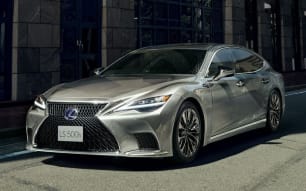The Lexus LS is it, the flagship sedan in the Japanese premium outfit’s line-up. It’s available in two trim levels, either the borderline aggressive F-Sport or plush Sports Luxury.
It’s also available with two drivetrain choices, with no price difference between them. The F-Sport starts from $195,953, before on-roads, while the one we’re testing here, the Sport Luxury starts from $201,078.
This pricing is below par for big luxury sedans designed to be ridden in rather than driven, making it a relatively good-value proposition straight out of the gate.
The entry-level Mercedes-Benz S-Class (the S450) starts from $243,890, the single version of the BMW 7 Series (740i M Sport) starts from $268,900, leaving only the Audi A8 (50TDI) even close when it comes to pricing, which starts from $202,700. We don’t get its Korean rival, the Genesis G90 in Australia yet.
‘Value’ or not, the LS has its work cut out for it, as this particular corner of the executive transport marketplace is probably more about badge cred than it is logic, and the 500 Sports Luxury is at a further disadvantage, as it doesn’t offer the Lexus unique selling point, a silky smooth hybrid system.
Ask yourself, when it comes down to it, if money was no object would you rather have a Grand Seiko or a Rolex?
Again, logic doesn’t apply, but the Lexus does offer pretty much everything buyers in this class should be after.
Inclusions on every LS are 20-inch alloy wheels, adaptive LED headlights, 12.3-inch multimedia touchscreen with Apple CarPlay, Android Auto, and built-in navigation, a 23-speaker Mark Levinson branded audio system, climate control with interesting ‘infra-red body temperature sensors’, heated and cooled front seats with 28-way power adjust, a heated steering wheel, full four-door keyless entry with push-button start, ambient interior lighting, a panoramic view camera, electric motion-sensing boot, radar cruise, and connected services.
Just to remind you this Sport Luxury grade is the one to be driven in, not drive yourself, unlike the F-Sport alternative it scores dual 11.6-inch rear seat entertainment touch panels with HDMI input, full quad-zone climate, power reclining for the rear outboard seats with message functions, a drop-down armrest console with a climate control panel, electric sunshades for the rear three windows, a cooler box, seat ventilation, and two additional airbags for the rear seats. Proper plush. Wish it came with a driver, too.
Things you miss out on for picking this one? Not much, the F-Sport scores a more aggressive dash, an 'LFA-Style' cluster, bolstered front seats, sport steering wheel, variable gear ratio steering with rear steering, high performance brakes, and active stabilisers.

